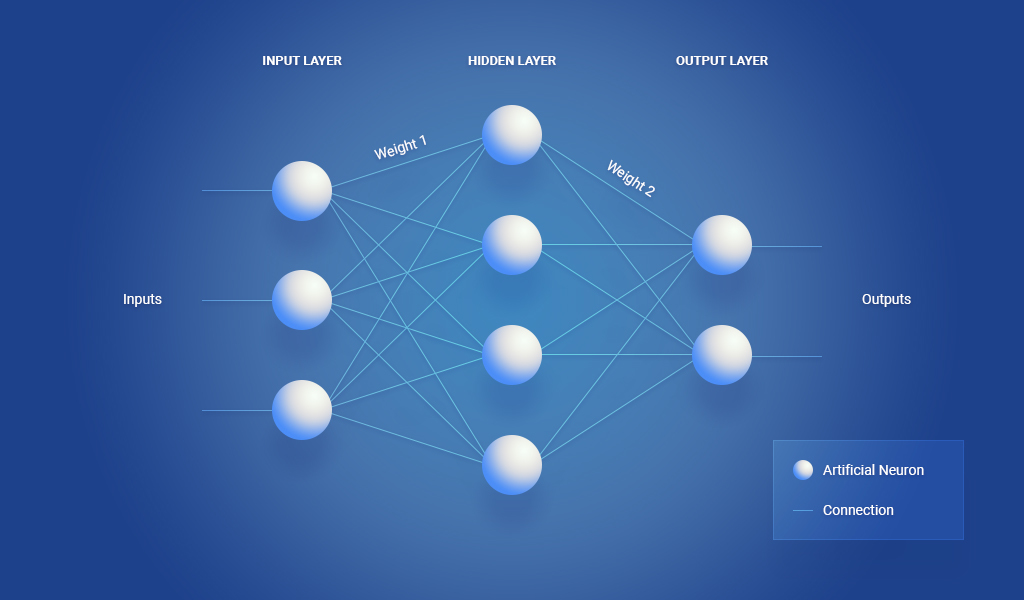Accelerating Business Growth With Artificial Neural Networks

Nowadays, we take artificial intelligence for granted, using it throughout our everyday lives.This giant leap in information and software technology has become possible partly thanks to a class of machine learning architectures and algorithms called artificial neural networks (ANN). The unique ability to learn and develop also makes ANNs a likely solution to some common business problems.
Let’s see how ANNs help achieve business growth. (If you are not really into the theory, you can just skip the first chapter and proceed to the applications of artificial neural networks in various industries.)
Artificial Neural Networks in a Nutshell
The human brain is a biological neural network that consists of 100 billion cells (neurons) connected by synapses. The neurons transmit information by forming connections with each other: if sufficient synaptic inputs to a neuron fire, that neuron fires too.
Similarly, an artificial neural network consists of multiple layers of artificial neurons called units or nodes. Input units receive from the outside world various types of information for the network to process. Output units sit on the opposite side of the network; they signal how it responds to the information. Between the input and output units, typically there are one or more hidden layers of units. Their job is to transform the input into something that output units can use.
Valuable connections transmit the output to each unit from the units of the previous layer. Each input/connection is given a weight, which can be a positive (if one unit excites another) or negative number (if one suppresses another). The higher the weight, the more influence one unit has on another.

ANNs can do something that conventional computer systems normally can’t: they learn, adapt and respond to new situations. The networks learn things typically through a feedback process called backpropagation:
- An output that a network should produce is predicted for a training set example.
- The error is calculated: it is the difference between the predicted and the actual output of the training set.
- Depending on the direction of the error, the difference is used to modify the weights of the connections, working from the output unit(s) through the hidden layer(s) to the input units.
- The process is repeated, let’s say, 10,000 times.
For learning, neural networks need large quantities of information to process. In the case of speech recognition, a training set may be a series of audio clips along with a description of what’s being said. For image analysis, it may include a large number of photos posted all over the Internet. The descriptions of the images must explain exactly enough of what the computer should see.
The neural network will try to classify each item, piecing together information from its various layers to make guesses about what it’s seeing or hearing. The machine’s answer is compared to the human-created prediction. In every error case, the network steps back through each of the previous layers of artificial neurons, changing the weights and bias values for the layer just enough to guess a little bit more correctly next time.
The layers gradually grow abler, and eventually, the error is reduced to the point where the network figures things out exactly as it should. This iterative process of passing a sample through the network and correcting itself is known as deep learning. If well-trained artificial neurons are allowed to ‘think’ about a new situation (i.e. receive an entirely new set of inputs), they should make a good prediction.
Packages for coding ANNs exist in C, C++, C#, Java, Javascript, Matlab, Octave, Perl, PHP, Python, Ruby, and other programming languages. And now we proceed to the main point.
What Are Neural Networks Used For?
ANN capabilities fall within very broad categories, and some deep learning methods have achieved human-competitive performance on certain tasks. They have found applications in a wide range of disciplines, including, but not limited to:
- pattern recognition (radar systems, face identification, signal classification, object recognition, etc.)
- system identification and control (e.g., vehicle control, trajectory prediction, process control, natural resource management)
- quantum chemistry
- playing board and video games and decision making
- sequence recognition (such as gesture, speech, handwritten and printed text recognition)
- medical diagnosis
- directing manipulators and prostheses
- finance (e.g., automated trading systems)
- data mining
- visualization
- machine translation
- social network filtering
- black-box models in geoscience (hydrology, ocean modeling and coastal engineering, and geomorphology)
… and many more. Currently, the most common application of the technology in computing is pattern recognition, ranging from optical character recognition to facial recognition. Design, architecture, banking services, mechanical engineering, agriculture, beauty industry, and many others are sure to benefit from smart image-based apps. However, this article deals primarily with the application of neural networks in business.
ANNs are used to build efficient target marketing. They can conduct customer segmentation by including purchasing patterns, economic status, and other characteristics. Amazon, Google, Netflix, Walmart, and other online businesses get millions of correctly targeted consumers with the help of recommendation engines. The use of ANNs for recommending consumer goods and services means more loyal customers and increasing sales.
Speaking about millions of customers… A company that has rich customer data can use machine learning models with ANNs to discover complex usage patterns and predict why certain customer categories leave. This helps reduce churn rate.
When utilized in consulting services, machine learning solutions help make smarter decisions and solve complex problems. ANNs are instrumental in data cleansing and extraction, data modeling, and algorithm development. Data modeling using deep learning helps enterprises create conceptual models based on the analysis of data objects.
Finance and insurance employ ANNs’ capability of prediction. The methods involving ANNs have proved successful and easy-to-use at ‘market trends’ forecasting. Since neural networks can examine a lot of information quickly and sort it all out, they can be used to predict stock prices. Eventually, it will also become easier to tackle risk management, implementation of trading strategies, and other trading-related situations using machine learning algorithms.
ANNs are helping banks at loan granting to make a decision based on past experience. The failure rate of loans approved in this manner is lower than that of some of their best traditional methods. Credit card companies also utilize ANNs that analyze statistical data about a person and their past failures. This helps them decide whether to grant an application.

Moreover, machine learning systems are capable of understanding anomalies in data patterns that differ from typical or historical transactions, which may be fraudulent transactions. The technology is thus useful in uncovering fraud and fraud prevention. Similarly, ANNs have empowered the insurance industry for detecting fraudulent claims and strange circumstances, segmenting policyholders for appropriate pricing, and managing special offers for groups of customers.
Neural networks are used in some email programs that automatically differentiate between spam and genuine emails. For writing emails, as well as reviewing documents and marketing content, professionals and firms worldwide are using automated proofreading software. Many ANN-based editing tools are available online for free, such as the widely acclaimed Grammarly. They pick up spellings and grammatical mistakes, show the correct way to write sentences, detect plagiarism, and suggest synonyms to improve the text readability. Additionally, they can analyze the user’s writing and suggest ways to improve writing skills.
Neural networks are an attractive but demanding business area. More companies and organizations are investing in ANNs as a possible solution to numerous business problems. Businesses may need the expertise of a data science team to estimate the value of such machine learning models and their impact on churn prevention, products and services quality, safety, fraud losses prevention, systems and processes optimization, and other factors which are key to business growth.
Our Experience with ANNs
If you are still wondering ‘What are neural networks used for?’, here is a first-hand account of ANNs’ abilities.
We have recently cooperated with the Neural Contract Company based in Melbourne, Australia. Its founder Michael Pattison is one of Australia’s best information technology lawyers. He also holds a MASc in Computer Science. After 30+ years of practice of law, Michael decided to concentrate on technology innovations for that industry. In 2016, he took the leap into entrepreneurship and started with creating ContractProbe.
ContractProbe is an automator of contract reviews. The online proofreading tool is designed for attorneys, notaries, and other professionals who deal with multiple legal documents daily. The user uploads a document in PDF, Word or plain text file, and in less than a minute is able to read a summary report.

ContractProbe is geared toward assisting lawyers and businesspeople as they review existing contracts and draft new ones. By reference to the vast database of agreements used in Australia, USA, and England, the service is able to detect:
- typical clauses, such as a clause specifying which law governs the contract
- unusual clauses
- missing clauses
For the latter, ContractProbe will provide an appropriate example that was used in similar agreements. The user can apply it as a template of the clause for their draft. Moreover, the service reports:
- unusual definitions
- defined terms that lack the definition
- defined terms that are not used in the agreement
- cross-reference errors

The mechanism is based on ANNs that recognize patterns in the uploaded texts. They have been trained on thousands of executed non-disclosure agreements, intellectual property licenses, independent contractor agreements, employment contracts, and other types of agreements. In addition, the artificial intelligence ‘front-end’ is further learning from each new document that ContractProbe processes.
Our developers implemented the backend for the ANN and modified its outputs to meet the owner’s functional requirements. The other team members involved were lawyers and programmers located worldwide.
Extending the biological metaphor, it is fair to say that the ANN develops a symbiotic relationship with the users (in this case, professionals and businesses). The neural network feeds on the data provided by the users, and the more it consumes, the abler it becomes. The users’ feedback stimulates its development as well. The network, in its turn, is beneficial to the users because it
- spares the reviewer’s time to proofread the documents and makes the work easier;
- reduces the risks of missing important clauses in legal contracts.
Conclusion
Taking inspiration from the human brain, artificial neural networks use different layers of mathematical processing to make sense of the various information they are fed. Neural networks learn and change over time, providing computers with a more intelligent and nuanced understanding of what confronts them.
The learning algorithm is being put to good use for a variety of real-life tasks. The applications range from digital marketing to trading, from finance management to production, and beyond. The technology has an enormous potential for introducing new means to accelerate business growth. The progressive software systems can save the business’ time, reduce costs, assess risks, increase profitability, improve engagement, conversions and retention of customers, help ensure quality, increase safety, improve the manufacturing systems, give the company a competitive advantage, and help generate more sales.
Do you feel it’s high time to fuel your business with the power of ANNs? Would you like to make artificial intelligence a part of your company’s growth strategy? Are you looking for a reliable IT partner to build a digital solution for your startup? We can do it!
Content created by our partner, Onix-systems.
 Home
Home